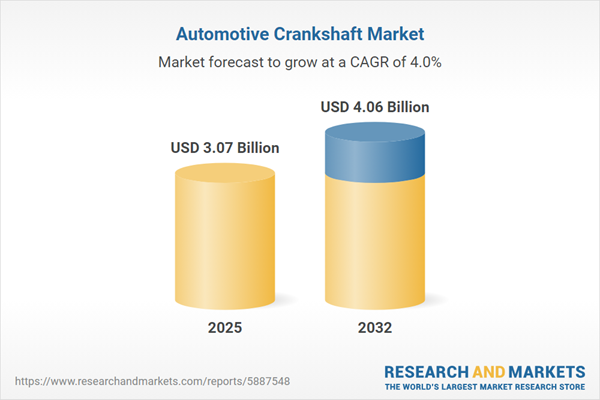Speak directly to the analyst to clarify any post sales queries you may have.
The automotive crankshaft market plays a pivotal role at the intersection of engine innovation and manufacturing strategy, offering decision-makers actionable intelligence to optimize powertrain performance, supply chain resilience, and competitive positioning.
Market Snapshot: Automotive Crankshaft Market Performance and Growth Outlook
The automotive crankshaft market expanded from USD 2.95 billion in 2024 to USD 3.07 billion in 2025, reflecting growing importance in internal combustion engine advancements. Sustained by a CAGR of 4.03%, the sector is projected to reach USD 4.06 billion by 2032, driven by robust demand across commercial and passenger vehicle segments, steady R&D investment, and the industry’s response to evolving emissions regulations.
Scope & Segmentation Overview
- Vehicle Types: Heavy commercial vehicles, light commercial vehicles, passenger vehicles.
- Material Types: Billet steel, cast iron, forged steel.
- Engine Types: Alternative fuel (CNG, LPG), diesel (CRDI, TDI), and gasoline (direct injection, port injection).
- Production Processes: Die casting, investment casting, sand casting, closed die forging, open die forging, CNC machining, traditional machining.
- Distribution Channels: Aftermarket (authorized service centers, independent dealers, online retailers), OEM (in-house manufacturing, tier-1 manufacturers).
- Regional Coverage: Americas (United States, Canada, Mexico, Brazil, Argentina, Chile, Colombia, Peru), Europe, Middle East & Africa (including United Kingdom, Germany, France, and more), Asia-Pacific (China, India, Japan, Australia, South Korea, others).
- Profiled Companies: Aisin Seiki Co., Ltd., Thyssenkrupp AG, Tenneco Inc., Mahle GmbH, Bharat Forge Limited, Mubea International GmbH, Hyundai Dymos Co., Ltd., SIFCO Industries, Inc., Sango Co., Ltd., Mitsubishi Heavy Industries, Ltd.
Key Takeaways for Senior Decision-Makers
- Continuous advancements in crankshaft design, material science, and manufacturing technologies increase operational life and support powertrain efficiency targets in light of strict regulatory pressures.
- Hybridization and electrification trends are influencing crankshaft specifications to enable seamless integration with electric motors and accommodate diverse fuel platforms.
- Additive manufacturing and advanced surface treatment techniques are enabling lighter, more resilient components and reducing maintenance intervals.
- Supply chain diversification and localized production footprints help mitigate risks from market volatility and trade-related disruptions.
- Aftermarket and digital service models, including predictive maintenance and remote monitoring, are creating new revenue streams and extending product lifecycle value.
Tariff Impact: Strategic Responses to Trade Disruption
The introduction of United States tariffs on imported steel and aluminum in 2025 has influenced sourcing decisions, prompting manufacturers to pursue alternate suppliers and invest in domestic capacity. Companies with global operations benefit from production in tariff-exempt regions, while joint warehousing and multi-year contracts strengthen supply chain stability and help control costs. Enhanced collaboration across the value chain has resulted in more resilient risk-sharing frameworks and improved yield management, fostering adaptability in the face of policy shifts.
Automotive Crankshaft Market: Methodology & Data Sources
This analysis utilizes a blend of in-depth secondary research and selective primary interviews to validate market insights. Sources include regulatory filings, patent databases, association publications, and direct engagement with OEM engineers and forging experts. Standardized frameworks, including Porter’s Five Forces and PESTEL, inform the competitive analysis, while multi-point data triangulation and expert reviews enhance the accuracy and relevance of reported findings.
Why This Report Matters
- Enables informed decision-making on manufacturing innovation, supplier diversification, and market expansion strategies.
- Supports effective risk management in response to tariff volatility and regulatory evolution.
- Guides investment priorities with clear segmentation, technology adaptation, and regional opportunities in the automotive crankshaft market.
Conclusion
This report provides essential clarity on technological advances, supply chain strategies, and market segmentation shaping the automotive crankshaft environment. Leaders leveraging its insights will be better equipped to anticipate industry trends, maximize operational resilience, and drive sustained value in the evolving powertrain sector.
Additional Product Information:
- Purchase of this report includes 1 year online access with quarterly updates.
- This report can be updated on request. Please contact our Customer Experience team using the Ask a Question widget on our website.
Table of Contents
3. Executive Summary
4. Market Overview
7. Cumulative Impact of Artificial Intelligence 2025
Companies Mentioned
The companies profiled in this Automotive Crankshaft market report include:- Aisin Seiki Co., Ltd.
- Thyssenkrupp AG
- Tenneco Inc.
- Mahle GmbH
- Bharat Forge Limited
- Mubea International GmbH
- Hyundai Dymos Co., Ltd.
- SIFCO Industries, Inc.
- Sango Co., Ltd.
- Mitsubishi Heavy Industries, Ltd.
Table Information
| Report Attribute | Details |
|---|---|
| No. of Pages | 193 |
| Published | November 2025 |
| Forecast Period | 2025 - 2032 |
| Estimated Market Value ( USD | $ 3.07 Billion |
| Forecasted Market Value ( USD | $ 4.06 Billion |
| Compound Annual Growth Rate | 4.0% |
| Regions Covered | Global |
| No. of Companies Mentioned | 11 |









